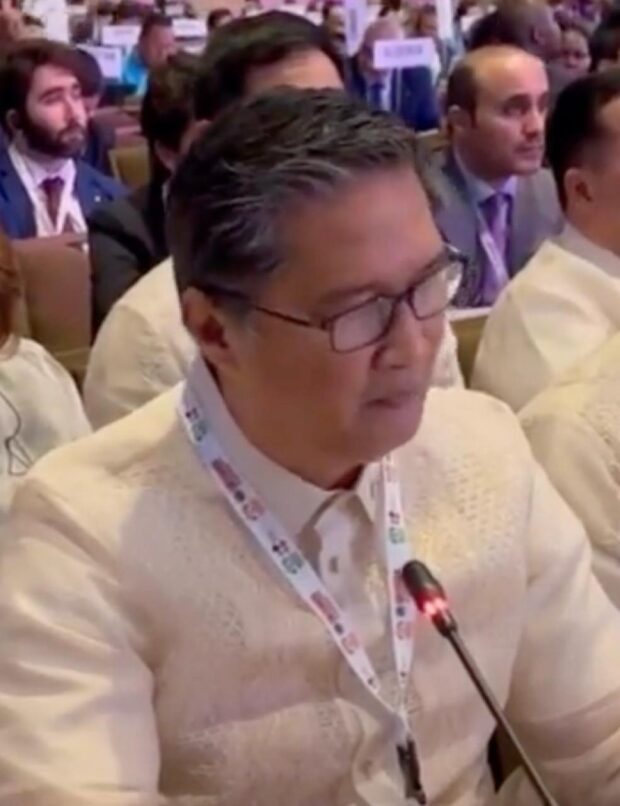
Senior Deputy Executive Secretary Hubert Guevara, head of the Philippine delegation to the 10th Conference of Parties.
PANAMA CITY–The Philippines and New Zealand expressed support for tobacco harm reduction (THR) at the ongoing Conference of the Parties (COP) of the World Health Organization’s Framework Convention on Tobacco Control (FCTC), citing their progress in combatting the smoking problem.
Delegates from 183 nations are gathering in Panama for the 10th Conference of the Parties (COP 10) to enhance and advance tobacco control and direct the future of the WHO FCTC in fighting the tobacco pandemic, which kills 8.7 million people worldwide every year.
Senior Deputy Executive Secretary Hubert Guevara, the head of the Philippine delegation to the 10th COP, said the country has made significant progress in implementing the FCTC with the Philippine Global Adult Tobacco Survey (GATS) showing a significant decrease in tobacco use from 23.8 percent in 2015 to 19.5 percent in 2021.
“This key achievement is the result of a collective and balanced approach, with whole-of-society and whole-of-government efforts, in advocating for and implementing effective policies and legislative measures,” he said.
Guevara highlighted that in 2022, the Philippines enacted Republic Act No. 11900, or the “Vaporized Nicotine and Non-Nicotine Products Regulation Act” to regulate vaporized nicotine and non-nicotine products (VNNPs) and novel tobacco products (NTPs).
“We emphasize the importance of tailored, multi-sectoral approach to FCTC implementation, acknowledging Article 1(d) of the FCTC, varying national contexts and priorities, and domestic legislation. The Philippines will continue to engage constructively in dialogue and collaboration with fellow parties of this conference to overcome the various challenges in realizing the aims of the convention as part of our unwavering commitment to the WHO FCTC,” he said.
“PH’s landmark legislation”
Guevara described RA 11900 in the Philippines as a “landmark legislation”, which aims to reduce the harm caused by smoking, and establishes a comprehensive and differentiated regulatory framework for the importation, manufacture, sale, packaging, distribution, use and communication of vaporized nicotine and non-nicotine products, along with other novel tobacco products.
The law safeguards minors by restricting the sale, including online trade, distribution, and marketing of VNNPs or NTPs, and prohibits tobacco product-related activities within 100 meters of schools, playgrounds, and facilities frequented by minors, he said.
Guevara said this is in addition to the various legislative measures already in place in the Philippines such as the Tobacco Regulation Act of 2003, the Graphic Health Warning Law, and Excise Tax Laws on novel tobacco products.
Guevara said the government sources funding for essential government services including the majority of universal healthcare and COVID-19 recovery initiatives, as well as infrastructure projects such as farm-to-market roads, schools, hospitals, and rural health facilities from excise taxes on tobacco and vapor products, which in 2022 amounted to almost $3 billion.
He said that in adherence to FCTC Article 6, since enacting the relevant law in 2012, the Philippines has consistently increased excise tax rates on cigarettes and tobacco products, making cigarettes less affordable, and consequently decreasing consumption.
The Philippines is also in the process of enacting a new legislation entitled “Anti-Agricultural Economic Sabotage Act” that declares the smuggling of tobacco as economic sabotage and aims to abate illicit tobacco trade in the Philippines.
NZ example
Meanwhile, the head of delegation of New Zealand, also expressed strong support for harm reduction, noting the substantial decline in smoking rate to 6.8 percent from 8.6 percent in the previous year and 16.4 percent in 2011-2012, with its approach also involving implementation of evidence-based harm reduction measures.
“We are proud of this progress, and how close we are reaching our smoke-free goal of less than 5 percent. We have achieved this through a mix of FCTC-endorsed measures including regulation, community-based initiatives and targeted stop smoking support. Our approach has also involved a considered implementation of evidence-based harm reduction measures,” according to New Zealand’s head of delegation.
New Zealand’s approach includes making a range of nicotine replacement products available to people who smoke, including therapeutic products like patches, gum and smoking cessation medicines.
“We have regulated vaping products under our smoke-free legislation. This has included restrictions on where they can be sold and who can sell them, advertising and sponsorship bans, bans on vaping and smoke-free spaces, and bans on selling to those who are under the age of 18,” she said.
She said, however, that despite the low smoking rates for all groups of New Zealanders, daily smoking rates for Maori people, low-income earners, adults with disabilities and people experiencing mental distress and addiction issues are higher than others.
“To achieve 5 percent daily smoking rates for all population, we will continue to be ambitious and deliberate. In addition to our existing evidence-based tobacco control strategies, we are focused on providing people with practical tools and support to help them become smoke-free. We are investing in support for people who smoke including collaboratively-designed public health campaigns and targeted stop smoking services,” she said.
“New Zealand is proud to be party to the WHO Framework Convention on Tobacco Control and of the continued commitment of the parties to reduce the harm caused by tobacco products.”

